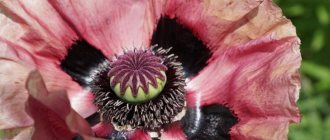Description of morning glory sweet potato
The culture belongs to the Bindweed family. Local residents value them for their taste and nutritional value. The herbaceous plant is characterized by short stature, its height does not exceed 30 cm. The bush spreads 1.5-2 m in width.
Flowers are light lilac, white and pink. Because of their funnel-shaped shape, they resemble gramophones. Their diameter does not exceed 5 cm. The inflorescences are formed from several single buds. It should be noted that when cultivating domestic varieties of morning glory sweet potatoes, special attention is paid to such a feature as the decorativeness of the leaves.
Distinctive features also include:
- spindle-shaped tuberous root system;
- liana-like shoot;
- heart-shaped leaves decorated with a pointed end. Their length ranges from 3 to 14 cm;
- elongated seeds (up to 6 mm). They are located in an angular woody box. Each seed is in a separate chamber;
- purple, yellow or pink fruits.
Edible tubers are formed on the lateral roots. The flowering period begins in mid-July.
The height of morning glory sweet potato does not exceed 30 cm. Recently bred varieties do not form inflorescences. In decorative varieties, the length of leaf blades often reaches 15 cm. Their color can be either variegated or monochromatic. Ripe tubers are characterized by their small size. Under favorable conditions it grows quickly. It is often used as a ground cover.
Morning glory in combination with other plants and in landscape design
For landscaping, Ipomoea Sweet Potato is often used with large decorative foliage of different colors: different shades of green, yellow and red. Variegated varieties with pink or white specks against a background of greenery have been developed. For flower arrangements, different varieties of this morning glory are combined.
Morning glory goes well with other plants used for vertical gardening: campsis, wild grapes, ivy, hops. It looks elegant next to deciduous trees.
Morning glory is often used for vertical gardening
In landscape design, it is used to decorate open terraces and gazebos. It is often placed next to antique-style structures or lanterns, and also decorates walls, fences, gates, and columns.
In horizontal decoration, plants of contrasting shades look impressive, decorating one surface, a flower bed, or a living carpet. A living fence of plants with leaves and flowers of different colors is picturesque. The effect is enhanced by proximity to conifers.
If you cover the arch with moon-flowering morning glory, then with the right lighting, the snow-white flowers will look like fairy-tale lanterns. And their amazing aroma will add even more mystery and charm to the summer garden.
The composition looks great with flowers planted in garden vases, which, if there is a frame above them in the form of a flower bouquet, will first encircle it and then hang down almost to the green lawn.
Blooming morning glory looks good on a high pergola
Varieties of morning glory sweet potato
There are quite a few varieties of this culture. They are classified based on where they grow.
The Margarita variety can be planted in open ground. In this case, the deciduous plant reaches 30 cm, the length of the loop is 2 m. There are no flowers; gardeners value this variety for its decorative leaves. If the climate is unstable, morning glory sweet potatoes are grown as an annual. To achieve rapid growth, the hanging plant must be pinched during the growing season.
The purple variety differs from other varieties in its resistance to diseases and the pubescence of the stem. The length of the latter reaches 8 m. The dark green leaves have a smooth surface. Double inflorescences appear in early summer. They can be snow-white, soft pink, purple and red.
The list can be supplemented with the annual variety Mina Lobata. The densely growing crop produces flexible shoots. The stem is decorated with dark green leaf blades, which are distinguished by three-lobed stems.
Unusual inflorescences appear in the axils. At first, the spike-shaped brushes are bright red, then acquire a shade ranging from orange to snow-white cream.
The list of ornamental varieties of morning glory sweet potatoes is quite extensive.
| Variety | Sheet | ||
| Series | Subseries | Color | |
| Sweet | Caroline | Bronze | Bronze, externally reminiscent of maple. |
| Purple | Violet-purple, five-lobed. | ||
| Light Green | Light green, maple-shaped. | ||
| Red | Five-lobed, reddish. | ||
| Raven | Strongly cut, purple. | ||
| Bewitched | Unusual, bronze. | ||
| Green Yellow | Variegated, narrow. Decorated with light spots, golden and white touches. | ||
| Sweetheart | Red | Coloring depends on age. Mature plants are decorated with purple-green foliage, young plants are soft green. | |
| Purple | Undivided, grey-green. | ||
| Light Green | Lobed and whole, golden-green. Young ones are decorated with a bright purple border. | ||
| Heart | Light | Heart-shaped, light green in color. | |
| Purple | Purple, heart-shaped. | ||
| Illusion | Midnight Lace | Lobed, strongly cut, black-green. | |
| Garnet Lace | Light bronze, split, decorated with purple veins. | ||
| Emerald Lace | Delicate green, lanceolate. | ||
| Lady Fingers | Green, dissected, riddled with purple veins. | ||
| Pink Frost (Tricolor) | Solid, decorated with light strokes and pink edging. | ||
| Ace of Spades | Black, small size. | ||
All hybrids are divided into three categories:
- dessert;
- feed;
- vegetable.
The first group includes the following varieties: Chestnut, Amish Red and Korean purple. The following varieties have good taste: Amish Red, Beuregarde, Japanese, California Gold. Forage varieties include Brazilian and White Bouquet. Desserts are distinguished by their savory features.
They taste like carrots, melon, banana and pumpkin. They are often used to make wine and jam. Ipomoea Sweet Potatoes replace potatoes.
You can grow quite a few varieties at home. Kumara Red loves warmth and light. To ensure the latter, additional sources are used. This variety produces yellow oval tubers. The stems are decorated with large size and splendor.
Burgundy is one of the earliest varieties. The tubers are red, the leaf blades are quite large. Bright inflorescences exude a pleasant aroma.
Popular types and varieties
Various varieties of morning glory are used to decorate the garden and summer cottage.
The most popular type is small-flowered purple morning glory:
- annual liana, length – up to 5 m;
- the greens and stems are covered with short fluff, the leaves are lanceolate or heart-shaped;
- flowers are funnel-shaped, diameter - about 5 cm;
- shades of gramophones: bluish-lilac, pink, blue, purple, blue;
- grows quickly, takes root well in different conditions, purple morning glory is resistant to diseases and pest attacks;
- flowering period - from the beginning of June until the onset of the first frost;
- Many species are considered poisonous; bindweed is practically not grown indoors.
Popular varieties:
- Grand Pa.
- Gypsy girl.
- Mauro.
- Beauty of Moscow.
- Venice is blue.
Other types and varieties of morning glory:
- tricolor. Large “gramophones”, smooth leaves, spectacular flowering. Over the course of the season, the bud changes color from red-violet to blue and returns to pale purple. Varieties: Flying Saucer, Giselle, Blue Star;
- quamoclit. The original shape of the buds is a pentagon. In nature, flowers of different shades are found on the same vine. Pink, red, white buds + openwork foliage are exquisite elements for landscape design, garden decor, loggias and balconies;
- Cairo. Numerous medium buds, color - blue, vine length - up to 5 m, trunk dense, thick. Bright green palmate leaves, showy appearance;
- Japanese Numerous varieties with decoration: borders, inclusions, stripes, small spots. The funnel-shaped flowers are larger than purple morning glory;
- sweet potato. The original type of vines differs from other varieties of bindweed. Small edible tubers are formed on the roots, which are used to propagate the unusual morning glory. The liana is quite short: from 1 to 2 m, the leaves are of various shapes and shades: not only dark and light green, but also purple and brown. Variegated varieties of bindweed with tubers on the roots look impressive. Flowers are purple, yellow, white, pink, buds (single or two or three) are formed in the axils of the leaves. Ipomoea sweet potato is suitable for decorating tall vases near the entrance to the house, hanging baskets and flowerpots. Original vines are also used as hanging plants. This species is allowed to be grown in an apartment;
- moonflowering. Delicate white flowers (10 cm in diameter) and rich aroma are characteristic features of the species. Lunar morning glory blooms at night and on cloudy days; during the day and in sunny weather the buds are closed. The length of the vine is up to 6 m.
Rules for planting morning glory sweet potatoes
Ipomoea Sweet Potato is a crop that does not have any special requirements for its growing location. Plants are moved into open ground towards the end of the last spring month. The boxes should be placed on window sills that are located on the south or southeast side. A lot depends on the lighting at this stage. You should also pay attention to protection from drafts. Its absence will negatively affect the seedlings.
Soil requirements
It should have neutral acidity and allow air and moisture to pass through well. Experienced gardeners prefer loamy and sandy loam soils. If the acidity is high, it is stabilized with lime. Before planting, make a substrate containing humus, sand and turf soil. Garden soil is useless in this case. It has too few nutrients. When using such soil, the likelihood of infection by parasites and diseases increases.
Preparing seeds and growing seedlings
Pre-sowing preparation is quite simple. The seeds are soaked in a solution of potassium permanganate. Then they are placed in the ground to a depth of 1.5-2 cm.
To save time, seed can be placed directly into large pots and hanging flowerpots. To create favorable conditions, the container in which the morning glory sweet potato is planted should be covered with a transparent film. Ventilation must be carried out daily. This will avoid condensation. It is removed after two weeks.
The air temperature in the room should vary from +18 to +25 °C.
Growing annual morning glory from seeds
Ipomoea purpurea stars of paradise planting seeds and care photo
Sowing in the ground
Morning glory is sown in the ground from the end of March to mid-May . The seeding depth is 1-2 cm. Sow in rows sparser, leaving 5-6 cm between seeds. The sowing site is usually chosen next to a fence, gazebo or other vertical support that the plant will entwine. It is necessary to water in moderation so that an earthen crust does not form on top. The seeds germinate in a couple of weeks and grow quite quickly, drowning out the weeds. But you shouldn’t rely on the “survivability” of morning glory; all the weeds need to be weeded, and the seedlings need to be thinned out, leaving a distance of 7-8 cm.
Morning glory can be sown before winter in the fall , at any convenient time, as long as weather conditions permit. The plant will not sprout until spring; the seeds require stratification. The liana aggressively reproduces by self-sowing, keep this in mind if you sow it in the garden: you still won’t be able to remove the seed pods in time, there will be too many of them. Therefore, give the beauty a place where she will not clog the cultural plantings.
Planting morning glory sweet potatoes in open ground
The timing depends on climatic conditions. Usually landing occurs at the end of May.
The soil is prepared in the autumn. The selected area should be dug up and fertilized with humus. When choosing mixtures for fertilizing, you need to be guided by the initial state of the soil. To improve it, superphosphate and potassium fertilizers are used. In the spring, all that remains is to loosen the soil and feed it with ammonium nitrate.
Before starting the procedure, water the ground with a light pink solution of potassium permanganate. The seedlings are placed in holes, the depth of which is about 15 cm. 30-35 cm are left between the sprouts. After planting, the soil is compacted and watered with warm water. The seedlings are covered with transparent containers. They are removed after new leaves appear.
One of the most festive vines for the garden is morning glory quamoclite
Ipomoea quamoclite is a heat-loving tropical vine with elegant leaves and gramophone flowers.
The representative of the genus Ipomoea looks especially attractive when planted in hanging baskets or in the design of gazebos, ridges, open balconies, and also as a hedge.
In addition, the plant has high growth rates and vegetative development, subject to simple care requirements, which makes the culture popular among gardeners.
Botanical description
Quamoclite belongs to the Convolvuláceae family, comes from Latin America and Mexico and is a perennial flowering plant with a long climbing stem reaching up to 5 m in length and having the ability to easily climb any support.
https://www.youtube.com/watch?v=ImXK0QEtc8Q
In addition, among the distinctive characteristics of culture, experts identify:
- fan-shaped dissected or heart-shaped leaves up to 15 cm long;
- funnel-shaped corollas with a diameter of up to 10 cm;
- buds of white, crimson, purple or blue;
- spherical fruits with 4 seeds.
A characteristic feature of morning glory is the ability to “roll” the buds into peculiar tubes under the influence of bright sunlight during the daytime. In the evening and morning periods, the corollas of the vines bloom again.
Popular types of morning glory
The genus Ipomoea has about 1000 species and is the largest in its family. Of the variety of these plants, more than half are used in landscape design.
In our country, almost all garden types of morning glory are grown as annuals, since they react negatively to even the slightest temperature fluctuations.
About 25 species and varieties of morning glory are considered the most common, but even fewer are grown in our country.
Blue
Ipomoea violacea is a long 5-meter vine with large sky-blue corollas up to 10 cm in diameter.
During the selection process, the following varieties were developed based on this species:
- firmament;
- Perly Gates;
- Blue Star (Blue Star;
- Flying Saucers (or Flying Saucer).
During the flowering process, morning glory buds change color and become crimson.
Ipomoea violacea in the photo:
Purple
Ipomoea purpurea is a perennial liana with a short pubescent stem and leaf blades, reaching a length of 8 m. The plant is characterized by scarlet, pink, purple inflorescences-clusters. The size of one flower can reach up to 7 cm.
Purple morning glory blooms until the first frost.
Among the main varieties of the species are:
- Star Scarlet;
- Scarlett O'Hara;
- Grandfather Otts;
- Sunrise Serenade;
- Milky Way.
Tricolor
Ipomoea tricolor reaches a height of up to 5 m. It has wrinkled, elongated, heart-shaped leaves. The buds are collected in groups of 3-4 funnel-shaped flowers. A characteristic feature of the culture is considered to be a gradual change in the color of the corolla - when flowering fades, the blue tint is replaced by crimson or lilac.
The following varieties were obtained through selection:
- Wedding bells;
- Rainbow Flash.
Ultraviolet
Ipomoea ultraviolet reaches only 3 m in length, but has large inflorescences with a diameter of up to 10 cm. The culture is characterized by a high level of seed germination (more than 90%) and an extremely strong stem.
Types and varieties of morning glory quamoclite
In the regions of central Russia, only 4 species of this subgenus are cultivated.
Pinnate
The most common garden species for growing is considered to be the pinnate quamoclite, or cypress vine.
Natural conditions for Quamoclit рennata are the tropical zones of Mexico and America. There the plant is most often found along roads or in cultivated fields.
The main cultural differences are:
- 3 meter height;
- segmented long leaf blade (about 9 cm);
- pointed petals on funnel-shaped corollas;
- bright pink, scarlet or white color of the buds;
- flowering from August to October.
Based on this species, new varieties were obtained in the process of breeding work:
- Kremlin star - so named for its bright scarlet buds;
- Whit Feather - has white flowers;
- Twinkling stars - a mix of different colors.
Ipomoea quamoclite pinnate in the photo:
Blade
Quamoclit lobata, or star bindweed, reaches 3 m in one growing season.
The characteristic features of the species are:
- strongly branching shoots;
- purple-brown color of the main stem (becomes dark green over time);
- inflorescence-spikelet.
Another fundamental difference is the specificity of the flowering of the crop: buds of several shades are simultaneously observed on one brush.
The phenomenon is due to the fact that a closed flower initially has the shape of a drop and a dark crimson or bright pink color, but, gradually opening, it acquires a lighter shade (up to beige).
Thanks to this quality, the species was popularly called the “Spanish flag”.
Red
Red morning glory Quamoclit coccinea is characterized by:
- thin 3-meter stems;
- scarlet tubular flowers with a yellow base;
- heart-shaped leaves up to 10 cm in length;
- short flowering period (June - July).
At the end of summer, the leaves of this species turn black and lose their attractiveness.
The liana of the fiery red ivy-leaved quamoclite has a longer decorative period. The culture has 5-lobed openwork leaf plates of dark green color, which are well preserved in their original form until late autumn.
Slaughter
Quamoclit Sloteri is a hybrid of red and feathery quamoclites.
Among its relatives stands out:
- medium height (up to 1.5 m);
- heavily dissected leaves;
- bright scarlet flowers with a white-yellow base.
Due to the interesting shape of the opened buds, the plant is popularly called the cardinal vine.
Planting and caring for morning glory quamoclite
The agricultural technology for growing morning glory quamoclite does not require special skills or abilities and consists of timely planting of the plant, thorough watering, fertilizing and loosening the soil.
The grown seedlings are planted on open plots of land in May. It is preferable to choose well-lit plots of land.
The procedure is carried out in the following order:
- Before planting, the soil is loosened and fertilizers are applied. To improve the quality of the soil, you can add humus, organic matter and a little sand.
- The grown seedlings are planted on the site, maintaining a distance of up to 50 cm between plants. The planting depth must correspond to the root system of the crop.
- At first, a greenhouse is built over the sprouts or covered with polyethylene.
- As necessary, the dried soil is irrigated with water.
As soon as the flowers get stronger, the greenhouse can be removed.
For rapid development, quamoclite needs regular irrigation. The planted area is watered once every 3 days. As a rule, 1 liter of liquid is enough for one plant. During drought, the frequency of irrigation increases.
To reduce water consumption and avoid cracking of the soil, the planting site is carefully mulched with various organic matter:
- hay;
- sawdust;
- shavings;
- husks from seeds.
For abundant flowering, the crop is regularly fed with mineral fertilizer complexes. Typically, the vitamin composition is applied once a week throughout the entire growing season.
Due to its intensive growth rate, morning glory requires additional fixation. The shoots of the plant are tied to a support, which allows you to form a variety of compositions.
To protect against spider mites (the most dangerous pest of quamoclite), the vine is sprayed with cold water every 3 days.
Growing from seeds at home
The easiest way to breed morning glory quamoclite at home is by sowing seeds.
To do this you need:
- sort planting material;
- Soak high-quality seeds for a day in slightly warm water;
- plant them in seedling cups (to a depth of 1 cm);
- pour water at room temperature;
- cover with film;
- move to a bright windowsill (with room temperature not lower than + 20°C);
- remove the polyethylene after germination;
- moisten the soil.
After the formation of 2 full-fledged leaves, the seedlings are transplanted into a larger container using the transfer method. Seedlings are kept in new pots until the weather warms up.
Germination of quamoclite in peat tablets and trays:
The variety of varieties and types of morning glory allows you to decorate any garden plot or flower bed. And simple agrotechnical requirements make growing the crop accessible even for gardeners with little experience.
Source: https://1decor.org/rasteniya/cvety/ipomeya-kvamoklit.html
Caring for morning glory sweet potato
Each crop requires regular agrotechnical procedures. The main requirement is compliance with the thermal regime. Morning glory is considered a heat-loving plant. It needs to be watered moderately but regularly. An excess of moisture is indicated by the appearance of white bubbles on the leaf blades. Immediately after moistening the soil, it is necessary to carry out mulching and loosening. Sick, weak or dried out shoots are pruned. Perennial plants are carefully inspected after wintering. Shoots that had to be removed during processing can be used as cuttings.
Feeding and fertilizer
To provide the plant with adequate nutrition, mineral and organic mixtures must be added to the soil. Wood ash is considered a universal fertilizer. For 10 liters of liquid, only 1 glass of the main ingredient is required. When using the complex, you should follow the attached instructions. Experts do not recommend using nitrogen-containing mixtures during the flowering period.
Wintering morning glory sweet potato
In autumn, the crop should be kept in a warm room. The air temperature should not be less than +25 ⁰С. Additional lighting becomes a necessity. Before wintering, autumn pruning is carried out. Leaving the plant in open conditions is strictly prohibited.
Home care
Temperature
Tropical plants do not like cold, but dry heat is also destructive for them. Therefore, the optimal temperature for indoor tricolor morning glory is 20 - 25 degrees. With the support of this temperature regime, the plant will bloom all year round.
Lighting
The more light, the more colors. Tricolor morning glory loves sunlight very much, but it must be diffused using a tulle curtain, mesh or parchment paper. Direct sunlight will cause burns and wilting. The liana will not die in the shade, but it will grow much slower and there will be fewer flowers.
Watering and humidity
Watering should be moderate. Tricolor morning glory does not like overflows and too wet soil. Excess water can cause roots to rot. Therefore, you need to water the plant only after the top soil layer has completely dried.
The soil
Expanded clay is poured onto the bottom of the pot for tricolor morning glory as drainage. The substrate should consist of leaf soil, vermiculite, crushed expanded clay, peat and coconut fiber in a ratio of 2:1:1:1:1.
Top dressing
Ready-made mixtures for home decorative flowering plants or cacti are suitable as fertilizer. In this case, you need to pay attention to the composition of the fertilizer so that it does not contain nitrogen, or its amount is insignificant. Because excess nitrogen leads to the cessation of flowering and increases the development of foliage.
Trimming
Tricolor morning glory “in captivity” turns into a perennial. Because of this, its lower stems become woody, and bald old shoots stick out through them. And the appearance of the vine loses its attractiveness.
In addition, tricolor morning glory grows very quickly. Therefore, the vine should be trimmed and pinched regularly.
In order for the shoots to grow in width and a lush, flowering crown to form, 3-5 shoots are left in the center. Each shoot is pinched over 4-6 leaves. And further pruning depends on the desired size of the vine and shape. The cut parts can not be thrown away, but rather replanted in a pot to rejuvenate the plant.
Transfer
Transplantation of tricolor morning glory is carried out once a year in early spring. The liana is transplanted into a larger container by transshipment, and the missing amount of soil is topped up.
Reproduction of morning glory sweet potato
Morning glory sweet potato can be obtained through:
- seeds This method is only suitable for experienced gardeners. The germination percentage is unlikely to be high, making it considered too difficult. It is most often used by breeders;
- tubers. Planting is carried out after the root crops acquire sprouts;
- cuttings. The shoot must have at least 2 internodes. After separation, the shoot is placed in water. After 5-7 days, roots will appear on it. At the next stage, you can begin planting morning glory.
Mr. Summer Resident recommends: beneficial properties of morning glory sweet potato and its use
The plant contains many useful substances. Vitamins, proteins, carbohydrates, micro- and macroelements - the list is quite extensive. Starch obtained during processing is often used in medicine. It can help with disorders in the gastrointestinal tract and immune system. Forage varieties of morning glory sweet potato are popular in cooking and livestock farming.
Tubers and other edible parts should not be eaten by pregnant women or nursing mothers. The same applies to people who are sick with diseases of the digestive system. Ipomoea sweet potato can be planted next to petunia, ornamental grasses, Europhobia, purslane, and lobularia. This plant is used to decorate garden paths and gazebos. Caring for morning glory does not take much time.
Diseases, pests and treatment of morning glory
Tricolor morning glory is very sensitive and often suffers from various diseases. As a rule, her “immunity” weakens from improper care.
As a result of excess moisture and overwatering, the vine is affected by fungi and rot. Often, tricolor morning glory cannot be cured of such ailments by pruning the affected areas and treating with fungicides. Therefore, the plant will have to be destroyed so as not to infect other indoor flowers.
Tricolor morning glory also suffers greatly from viral diseases. There are several dozen viruses that attack this plant. As with fungal diseases, the infected plant will have to be disposed of.
But among the parasites, tricolor morning glory attracts only aphids and spider mites. This problem can be solved by treating the vine with a soap solution or a ready-made insecticide.











